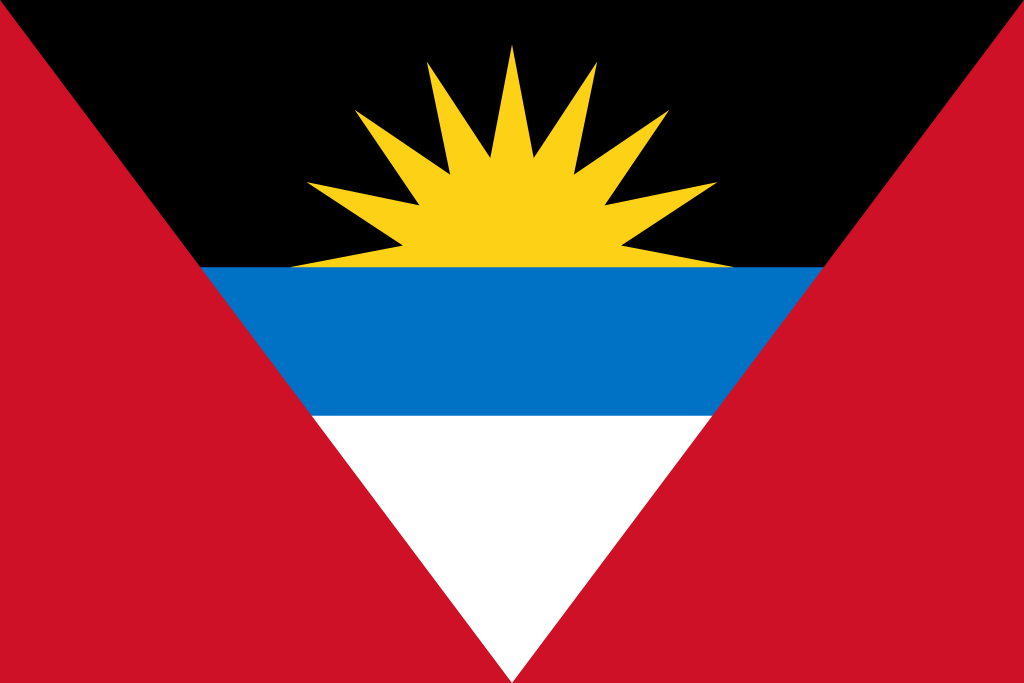Design and Color Symbolism:
The national flag of Antigua and Barbuda boasts an elegant and meaningful design, characterized by its horizontal tricolor composition. The three equally sized stripes, originating from the top and cascading downward, are thoughtfully arranged as follows:
Light Blue Stripe: The uppermost stripe is a captivating shade of light blue, reminiscent of the crystalline Caribbean skies that graciously blanket the islands. This serene hue metaphorically reflects the expansive realm of the sky and air, poignantly underlining the profound connection Antigua and Barbuda maintain with the celestial realm.
White Stripe: The central stripe, pristine and pure white, embodies a multitude of essential concepts. This segment signifies the untouched and powdery white sand beaches, an intrinsic facet of the islands' extraordinary natural beauty. Beyond this, the white stripe resonates with ideals of tranquility, unity, and harmony among the diverse inhabitants who proudly call Antigua and Barbuda their home.
Light Blue Stripe: The lowermost stripe harmoniously mirrors the color of the upper one, completing the captivating tricolor pattern. This light blue expanse symbolically pays homage to the expansive Caribbean Sea that envelops the islands, serving as an enduring testament to their distinctive geographical location and maritime heritage.
Significance of the Central Emblem:
Nestled upon the expanse of the white stripe, subtly offset toward the hoist (left) side, rests a visually captivating and symbolically loaded circular emblem. This emblem comprises two distinct concentric circles, each bearing its own significance:
Red Circle: The outer circle, boldly adorned in a shade of striking red, carries profound meaning. This vibrant color encapsulates the indomitable spirit, unwavering strength, and vital vigor that characterizes the Antiguan and Barbudan people. Serving as an homage to their tenacity and resolve in the face of adversity, the red circle stands as a testament to the resilience that has guided the nation through challenges.
Yellow Circle: Enclosed within the red circle, a smaller yet radiant yellow circle takes center stage. This luminous hue symbolizes the life-affirming energy of the sun, which graciously bathes the islands in its warmth and brilliance. More than just a representation of the physical sun, the yellow circle embodies the spirit of hope, optimism, and the promise of a radiant future for the nation and its citizens.
Historical and Cultural Context:
The flag of Antigua and Barbuda assumed its official status on the 27th of February in the year 1967. This date bears immense historical significance, marking the pivotal moment when the islands achieved self-governance within the esteemed framework of the British Commonwealth. Beyond its legal adoption, the flag's emergence marked a profound stride towards autonomous nationhood, embodying a rejuvenated sense of collective identity and purpose.
Through the harmonious convergence of design, colors, and the central emblem, the flag of Antigua and Barbuda encapsulates the storied history, geographical majesty, and aspirational spirit of the nation. A tangible embodiment of the islands' intimate bond with the Caribbean Sea, their awe-inspiring landscapes, and their populace's unyielding resolve to forge a trajectory of prosperity and unity, the flag resonates as a potent symbol.
In its essence, the flag of Antigua and Barbuda reverberates as a potent emblem, harmonizing echoes of the past, the present, and the future. It beckons as a source of unadulterated pride and unwavering inspiration for the citizens it represents, while simultaneously commanding recognition and reverence on the global stage.
Last Updated on: June 04, 2025